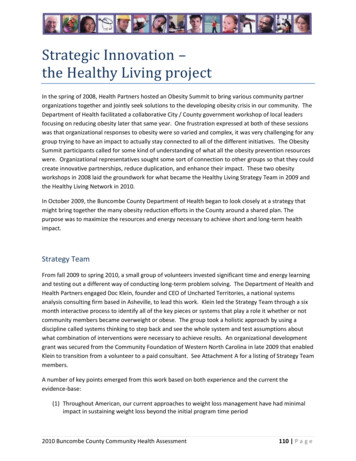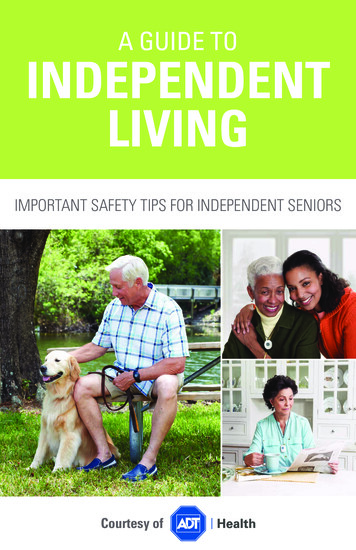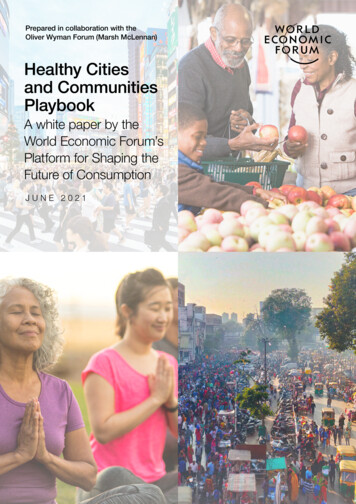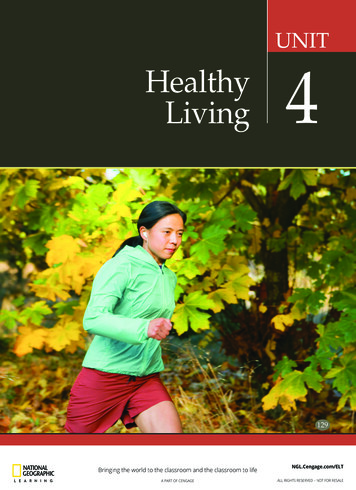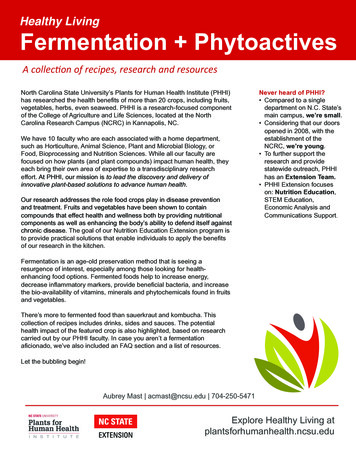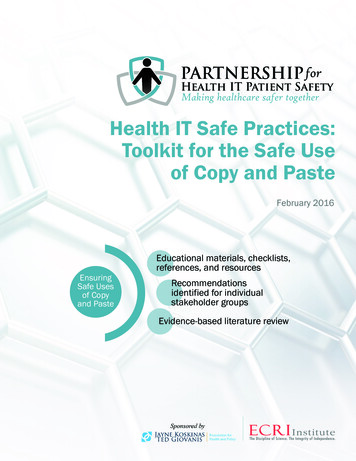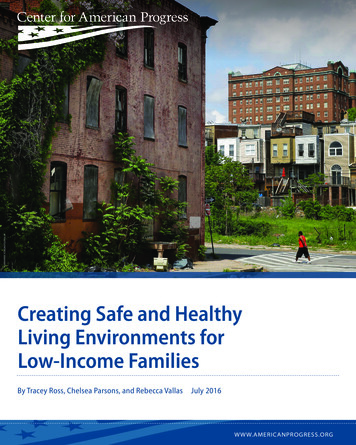
Transcription
AP PHOTO/PATRICK SEMANSKYCreating Safe and HealthyLiving Environments forLow-Income FamiliesBy Tracey Ross, Chelsea Parsons, and Rebecca VallasJuly 2016W W W.AMERICANPROGRESS.ORG
Creating Safe and HealthyLiving Environments forLow-Income FamiliesBy Tracey Ross, Chelsea Parsons, and Rebecca VallasJuly 2016
Contents1 Introduction and summary3 Safety and health hazards in homes6 Housing barriers for people with disabilities9 Neighborhood violence13 Recommendations to create safe and healthy livingenvironments for struggling families16 Conclusion17 About the authors18 Endnotes
Introduction and summary“Too many children in America have enough obstacles to overcome. Kids thatsee their opportunities in life limited by the color of their skin, or by the ZIP codewhere they grow up. They shouldn’t also have to come home and worry about thewater they drink or the air that they breathe.”— Secretary Julián Castro, June 13, 20161A strong home is central to all of our daily lives. People in the United States spendabout 70 percent of their time inside a residence.2 As the Federal Healthy HomesWork Group explained, “A home has a unique place in our everyday lives. Homesare where we start and end our day, where our children live and play, wherefriends and family gather to celebrate, and where we seek refuge and safety.”3Understanding how fundamental homes are to everything we do, it is troublingthat more than 30 million housing units in the United States have significantphysical or health hazards, such as dilapidated structures, poor heating, damagedplumbing, gas leaks, or lead. Some estimates suggest that the direct and indirecthealth care costs associated with housing-related illness or injuries are in the billions of dollars.4 The condition of housing is even more important for children,the elderly, and people with disabilities who need housing structures that supporttheir particular needs.The condition and quality of a home is often influenced by the neighborhood inwhich it is located, underscoring how one’s health and life expectancy is determined more by ZIP code than genetic code. According to a recent report byBarbara Sard, vice president for housing policy at the Center for Budget and PolicyPriorities, living in neighborhoods of “concentrated disadvantage”—which arecharacterized by high rates of racial segregation, unemployment, single-parentfamilies, and exposure to neighborhood violence—can impair children’s cognitivedevelopment and school performance.5 Residents of poor neighborhoods also tend1Center for American Progress Creating Safe and Healthy Living Environments for Low-Income Families
to experience health problems—including depression, asthma, diabetes, and heartdisease—at higher-than-average rates.6 This is particularly troubling given thatAfrican American, American Indian and Alaskan Native, and Latino children are sixto nine times more likely than white children to live in high-poverty communities.7The country’s affordable housing crisis is partially to blame for families and individuals tolerating substandard housing conditions and unhealthy neighborhoods.Half of all renters spend more than 30 percent of their income on housing—thethreshold commonly deemed affordable—while 26 percent spend more thanhalf their income on housing.8 While housing assistance programs such as publichousing and the Housing Choice Voucher program, commonly referred to asSection 8, provide critical support to families struggling to meet housing costs,only one in four households eligible for rental assistance actually receives it dueto limited federal funding.9 Furthermore, millions of Americans face evictionseach year. As work by Harvard University sociologist Matthew Desmond hashighlighted, eviction is not just a condition of poverty but a cause of it, trappingfamilies in poverty, preventing them from accessing and maintaining safe housingor communities, and corresponding with higher rates of depression and suicide.10This report provides an overview of the conditions of the nation’s housing stock,barriers to accessing housing for people with disabilities, the effects that neighborhood safety has on families, and recommendations for improving these conditions. Given how central homes and communities are to people’s lives, federaland local leaders must work to ensure low-income families have access to livingenvironments that are conducive to their success.2Center for American Progress Creating Safe and Healthy Living Environments for Low-Income Families
Safety and health hazards in homesMillions of American households don’t meet the most basic definition of ahealthy and safe home: dry, well ventilated, pest-free, hazard-free, well-maintained, and able to protect residents from extreme heat or cold. Nearly six millionhouseholds live with moderate to severe home health and safety hazards, whichplace them at-risk for illnesses and injuries including asthma, lead poisoning,falls, and respiratory illnesses.11 Estimates suggest that 6 million housing unitshave moderate to severe physical infrastructure problems, 6.8 million housingunits have elevated levels of radon, and 17 million homes have high exposure toindoor allergens.12 And while the country was outraged about the lead water crisis in Flint, Michigan, roughly 23 million housing units in the United States haveone or more lead-based paint hazards.13If a house or apartment was built before 1978, it is likely the structure containslead paint. Lead-based paint, even under layers of newer, lead-free paint, can breakdown because of age, poor maintenance, or household repairs, and can become ahealth hazard.14 Lead dust in the home is caused by chipping, peeling, flaking, ordeteriorating lead-based paint and can exist in even the cleanest of homes. Eachyear, lead poisoning—which can cause lifelong learning and behavior problems—affects an estimated 535,000 children younger than age 6.15 In fact, children whoare lead poisoned are seven times more likely to drop out of school and six timesmore likely to become involved in the juvenile justice system.16Many homes contain other hazards, such as mold, dust mites, or rodents, thattrigger and exacerbate serious health problems—particularly asthma, which is achronic inflammatory lung condition that affects the airways and a person’s abilityto breathe. In fact, 40 percent of asthma episodes are caused by preventable triggers in the home.17 On average, 1 out of every 10 school-aged children has asthma,resulting in 2 million emergency room visits, 500,000 hospitalizations, 14 million missed school days, and more than 56 billion in economic costs each year.Moreover, there is a racial disparity in asthma incidence: 13 percent of AfricanAmerican children have asthma compared to 8 percent of white children.183Center for American Progress Creating Safe and Healthy Living Environments for Low-Income Families
Recently, the U.S. Department of Housing and Urban Development, or HUD,announced a series of bold steps to protect children from lead in HUD-assistedhousing. This includes developing improved protocols for identifying andcontrolling lead hazards, such as adopting the Centers for Disease Control andPrevention’s more rigorous guidelines for measuring blood lead levels; evaluatingand improving current lead-prevention policies; strengthening HUD’s inspectionprocess and enforcing rules against properties in violation; and partnering withphilanthropic and government leaders to ensure residents have access to resourcesto protect them from lead.19 However, increased funding to HUD programs andPublic Housing Authorities, or PHAs, is necessary—particularly if there is anincrease in the number of lead hazards detected, thereby increasing the need torelocate residents. HUD also announced 46.5 million in Lead Hazard ReductionDemonstration grants to 15 local and state government agencies to address leadand other home health and safety hazards.20In addition, homes serve as the first line of defense for families against extremeweather, but millions are not equipped or well-maintained enough to serve thispurpose. For example, heat waves pose a major health risk to vulnerable groups,such as children and elderly people, and are one of the leading weather-relatedkillers in the United States, resulting in hundreds of fatalities every year.21 Havinga working air-conditioner reduces the risk of death from extreme heat by 80 percent.22 However, one in five low-income households do not have air conditioners,and many cannot afford the electricity to run them, making lower-income peoplemore vulnerable to extreme heat than other household. Low-income householdstypically spend 14 percent of their total income on energy costs compared with3.5 percent for other households.23 Improving energy-efficiency provides financialrelief to low-income families, and there are a number of relatively inexpensiveinterventions, such as weather sealing improvements, that may help keep inhabitants’ energy costs down.24 This is why it is critical to increase funding to programssuch as the Low Income Home Energy Assistance Program, or LIHEAP, whichhelps families with energy costs, and the Weatherization Assistance Program, orWAP, which provides funding for home energy upgrades. Unfortunately, bothprograms have faced cuts.25By comprehensively addressing the condition of homes—from basic repairs andenergy issues to major health hazards—families, particularly children, will be puton a greater path toward success.4Center for American Progress Creating Safe and Healthy Living Environments for Low-Income Families
Environmental justiceAt the beginning of the 20th century, zoning ordinances emerged as a way to separateland uses in order to protect people from health hazards. Over time, however, cityplanning and zoning ordinances focused less on public health and more on creatingidyllic communities, protecting property rights, and excluding marginalized groups,such as immigrants and people of color. Furthermore, new highways and waste facilities were constructed in marginalized communities, where they cut through businesses or homes and exposed residents to excessive pollution. Such practices continueto this day. Communities of color have higher exposure to air pollution, live near thehighest polluting facilities in the country, and disproportionately suffer the effects ofusing and drinking contaminated water. Environmental justice is a response to suchdiscrepancies and strives to ensure all people have environmental protections, regardless of their background.26The water contamination in Flint, Michigan, is a prime example of the failures of infrastructure and environmental quality that have threatened low-income communitiesand communities of color for generations. According to the Flint Water Advisory TaskForce, an independent body appointed by Gov. Rick Snyder (R-MI) to investigate thepresence of lead in the city’s water system, concluded: The facts of the Flint water crisis lead us to the inescapable conclusion that this is a caseof environmental injustice. Flint residents, who are majority Black or African Americanand among the most impoverished of any metropolitan area in the United States, didnot enjoy the same degree of protection from environmental and health hazards as thatprovided to other communities. Moreover, by virtue of their being subject to emergencymanagement, Flint residents were not provided equal access to, and meaningful involvement in, the government decision-making process.27Recently, in the wake of Flint’s water crisis, Democratic members of the U.S. Senateintroduced the Drinking Water Safety and Infrastructure Act to improve water infrastructure throughout the nation.28 Congress must ensure that communities have theresources to strengthen infrastructure, improve testing and monitoring of lead, andenhance regulatory oversight to protect the environment.5Center for American Progress Creating Safe and Healthy Living Environments for Low-Income Families
Housing barriers forpeople with disabilitiesAbout 57 million Americans—or one in five—live with a disability. For manypeople with disabilities and their families, securing affordable, accessible housingcan pose a tremendous challenge. While roughly 41 percent of public housingunits contain at least one disabled person, evidence suggests that units designatedfor people with disabilities are relatively sparse, and many of these units are likelyto be restricted to residents age 62 and older, making them unavailable to youngerpeople with disabilities.29 Similarly, HUD estimates that about 156,000 of theunits—or 11 percent—in its multifamily housing portfolio are accessible to people with disabilities, but only 73,000 are actually designated for them. Because 26percent of HUD’s multifamily housing developments are restricted to the elderly,once again, young people with disabilities are at a disadvantage.30Due to this lacking availability, a mere 3 percent of households in public housingwith a disabled member actually have a unit with accessibility features and only30 percent of those that requested accessibility modifications actually receivedthem.31 Meanwhile, about one in three households using Section 8 vouchers areheaded by a nonelderly person with a disability.32 But long waiting lists preventmany of these families from actually moving in to an accessible unit.33According to the 2010 Census, 41 percent of households with at least one personwith a disability—or 14.4 million households—are cost-burdened, meaning thatthey spend more than one-third of their income on housing.34 One report estimated that between 35 and 40 percent of households with “worst-case” housingneeds—where over half of income is spent on rent—are households containinga person with a disability.35 Furthermore, about 12.3 million people age 6 andolder—or 4.4 percent—need assistance with at least one activity of daily living such as “getting around inside the home, getting in or out of bed or a chair,bathing, dressing, eating, or toileting.”36 For example, in 2005, HUD and theUrban Institute conducted a study of disabled and nondisabled rental applicantsin Chicago. They found that at least one-third of the units advertised were not6Center for American Progress Creating Safe and Healthy Living Environments for Low-Income Families
accessible for people in wheelchairs to even visit, let alone live. Meanwhile, almostone in six housing providers denied requests to make wheelchair-accessible alterations to the unit, and 19 percent of those with on-site parking refused to providea designated handicapped space for the applicant.37 The variability of necessarymodifications speaks to the wide range of costs and many such alterations are notcovered by insurance.38People with disabilities not only can face physical barriers to securing affordable,accessible housing, but they also are especially likely to face housing discrimination. Indeed, disability- or accessibility-related complaints make up the majority of discrimination complaints that HUD’s Fair Housing Enforcement Officereceives.39 In fact, researchers have found that individuals with disabilities aremore likely to face negative treatment in the housing market than any othergroup.40 In the same study conducted by HUD and the Urban Institute, oneout of four calls conducted by deaf rental applicants using the teletypewriter, orTTY, system to inquire about units was refused service. Those who were servedreceived significantly less information and opportunities for follow-up than thecomparable hearing applicants.41Given the fact that a significant portion of the population is disabled, and disability is both a cause and consequence of poverty, it is necessary to ensure thenation’s housing stock is accessible—both in terms of the search for housing andthe accommodations themselves.7Center for American Progress Creating Safe and Healthy Living Environments for Low-Income Families
Aging in placeAccording to the AARP, “Older adults make up the fastest growing segment of the U.S.population, and as they retire and live longer on fixed incomes, the demand for quality,affordable, accessible housing in close proximity to services and other amenities willonly increase.”42 In fact, it is estimated that more than 5 million older Americans needservices and supports to remain in their homes, and nearly 90 percent of elders age 65and older would like to stay in their homes as long as possible.43 Aging in place allowsseniors to remain in their established social and community networks, which is alsoassociated with better health outcomes.44 Further, relocation can be financially burdensome to low-income older adults.45Currently, seniors renting single-family homes are allowed to make “reasonable modifications” for accessibility, but they must do so at their own expense because the FairHousing Act does not apply to buildings with fewer than four units.46 However, statescan use community-based waiver programs to offer home-based services to seniors.Still, individuals must be at risk for nursing home placements in order to be eligible, andthere are lengthy waiting lists.47 Fortunately, there are a number of steps local governments can take to support easier home modifications for seniors, including expediting permitting and review policies for upgrades, such as adding ramps to entryways;certifying contractors that specialize in aging-in-place modifications; and allocatingresources from housing trust funds or other revenue streams to subsidize the cost ofhome modifications for lower-income residents.48In addition, there are many housing policies to help seniors age in place, includingzero- and low-interest home modification loans, property tax deferrals that allowhomeowners to postpone payment until property sale or death, and re-zoning areas toaccommodate more compact residential development near transit stops and ensuringmore walkable areas.498Center for American Progress Creating Safe and Healthy Living Environments for Low-Income Families
Neighborhood violenceCrime and violence are often discussed as law enforcement matters, but these arealso public health issues critical to ensuring that families truly are living in safeand healthy environments. Overall, neighborhoods with higher crime rates tendto have high rates of poverty, as areas with lower crimes rates are less affordable.In other words, more affluent people are able to purchase safety and better lifeoutcomes by having access to housing in safer communities.Living in a neighborhood that experiences high levels of violence can have a devastating impact on an individual’s long-term mental health and wellness. A growing body of research has demonstrated that individuals who live in neighborhoodsplagued by high rates of violence increasingly suffer from trauma-related illnesses,such as post-traumatic stress disorder, or PTSD.50 One study of residents of highcrime neighborhoods in Atlanta found that one in three residents interviewedexhibited symptoms consistent with PTSD, including nightmares, difficultysleeping, trouble with concentration, and persistent fear or anxiety.51 A researcherin Philadelphia estimates that the rate of PTSD among residents of poor urbancommunities may be as high as 40 percent.52Exposure to neighborhood violence poses a particular concern for children. One2015 study found that more than one in four American children are exposed tosome kind of violence involving a weapon—including firearms, knives, rocks,or sticks—and this exposure was more common among youth who live in lowincome households and youth of color.53 A series of studies led by New YorkUniversity sociologist Patrick Sharkey demonstrated that exposure to neighborhood violence impairs children’s cognitive ability.54 One study found that withinjust one week of a homicide, preschoolers living nearby were “less able to controltheir impulses and pay attention, and they scored lower on pre-academic vocabulary and math tests.”55 In addition, parents displayed elevated levels of stress, whichcan also negatively affect children’s behavior and school performance.9Center for American Progress Creating Safe and Healthy Living Environments for Low-Income Families
Some efforts to deconcentrate poverty with the goal of reducing crime havecentered around public housing developments. In the early 2000s, the Chicagoand Atlanta housing authorities worked to address their distressed, high-crimepublic housing developments by demolishing their worst developments, relocating residents, and building mixed-income communities in their place. While it isoften difficult for residents to return to their communities after public housing hasbeen demolished, these particular instances provide insights about deconcentrating poverty. According to the Urban Institute, violent crime decreased more than60 percent in the Chicago neighborhoods between 2000 and 2008 and 13 percentin Atlanta between 2002 and 2009.56 Public housing has often been scapegoatedas the cause of crime, but studies suggest that “neighborhood conditions aredriving the high rates of homicide occurring in public housing areas rather thanthe unique physical and social environments of public housing developments.”57While there are benefits and drawbacks to interventions that focus on theseproperties, there is no panacea for addressing violent crime, and comprehensiveinterventions are necessary.In addition to efforts to deconcentrate poverty and create mixed income neighborhoods, state and local leaders need to invest in community-based programsthat address many of the underlying causes of violence.58 A recent report by theLaw Center to Prevent Gun Violence and the PICO National Network—entitled,“Healing Communities in Crisis: Lifesaving Solutions to the Urban Gun ViolenceEpidemic”—outlines how a combination of community-based interventionprograms and policy reforms is key to reducing urban gun violence. Communitybased models include partnerships between law enforcement, communitymembers, and service providers who work with the most at-risk individuals. Forexample, through gun violence intervention, or GVI, these leaders conduct aseries of meetings with at-risk individuals to make the case on behalf of the community that violence must cease or will result in increased law enforcement presence. According to the report, “this creates a powerful ‘focused deterrence’ effectthat has been shown to rapidly reduce violent behavior.”59Another proven strategy is hospital-based violence-intervention programs thatengage young people and help reduce violent crime. Victims of violent crime –particularly gang violence – are much more likely to trust medical professionalsthan law enforcement officials, making emergency rooms an important place tointervene. At the University of Maryland School of Medicine’s trauma center,the Violence Intervention Program is available for patients who have had repeathospitalizations due to violent crime.60 The program assigns patients a social10Center for American Progress Creating Safe and Healthy Living Environments for Low-Income Families
worker who creates a service plan that could include substance abuse treatment,job training, and conflict-resolution training. A study of this program—conducted between January 1999 and October 2001—found that individuals whodid not participate were six times more likely to be hospitalized as a result of aviolent assault and three times more likely to be arrested for violent crimes.61These programs show that identifying and working with the small segment of acommunity that is primarily responsible for violent crime is an effective strategyfor preventing further incidents.Domestic violence and homelessnessAccording to the CDC, 35.6 percent—or 42.4 million—of women in the United Statesand 28.5 percent—or 32.3 million—of men have experienced rape, physical violence,and/or stalking by an intimate partner at some point in their lives.62 Survivors mustbe able to leave their housing—and break their lease—in order to have the freedomto escape an unsafe situation. For example, in the District of Columbia, survivors canbreak their lease if they have received a court protection order or documentation from aprofessional—such as counselor, law enforcement official, or the D.C. housing authority—and give their landlord notice that they are terminating their lease as a result of thedomestic violence.63The need to leave domestic violence quickly is one of the key drivers of homelessness among women. According to one estimate, 92 percent of homeless women havebeen victims of sexual or physical violence during their lifetime, and 63 percent haveexperienced violence at the hand of an intimate partner as adults.64 One study foundthat women who endured domestic violence in the past year were almost four timesmore likely to be housing unstable—meaning that they have late rent or mortgagepayments, move frequently, and/or do not have their own housing—than their counterparts who reported no violence.65 During the 2015 National Census of Domestic Violence Services, a one-day survey found that more than 12,000 requests for services fromvictims—including emergency shelter, housing, transportation, child care, and legalrepresentation—could not be provided because programs did not have the resources toprovide these services.66 This gap in services underscores the need to increase fundingfor transitional housing under the Violence Against Women Act, and funding for sheltersunder the Family Violence Prevention and Services Act.11Center for American Progress Creating Safe and Healthy Living Environments for Low-Income Families
Domestic violence and homelessness con’t.In addition, organizations providing services to domestic violence survivors must offerholistic and comprehensive housing assistance.67 For example, Home Free—a HousingFirst program for survivors in Portland, Oregon—makes contact with an individual orfamily, and places them in a motel until permanent and confidential housing can befound.68 The organization helps clients access protection orders, provides immediatefinancial assistance, and ensures clients’ new units have safety features such as well-litentrances.69 The agency also educates landlords on survivors’ legal protections andsafety concerns.70 Home Free has seen considerable success with its approach, with 97percent of households finding safe housing and 86 percent remaining stably housedone year after graduating from the program.71Many communities also provide trainings to community members, professionals, andadvocates, ranging from classes for young adults on healthy relationships and dangerous behavior to trainings for nondomestic violence professionals—such as policeofficers and attorneys—on recognizing the dynamics of intimate partner violence.7212Center for American Progress Creating Safe and Healthy Living Environments for Low-Income Families
Recommendations to create safeand healthy living environmentsfor struggling familiesEvery American deserves to live in a place that is clean, healthy, and safe. There area number of programs and initiatives that address aspects of this goal—from leadabatement programs to violence prevention. However, a comprehensive, nationalcommitment is necessary to ensure that everyone lives in an environment conducive to their success. The next administration and Congress can lead the chargeon this as part of their governing agenda in 2017. The following are proposals thatpolicymakers should consider as part of such an agenda.Increase funding for efforts to fight lead poisoningWhile Secretary Castro’s recent announcement on actions to address lead hazardsin HUD-assisted housing is critical, Congress must ensure there is adequate funding to take up this fight. Previously, Congress voted to cut the budget for HUD’sOffice of Lead Hazard Control and Healthy Homes by one-third.73 Fundingthe office at 230 million, as called for by President Bill Clinton’s Task Force onEnvironmental Health Risks and Safety Risks to Children, would help protectchildren from this threat.74In addition, due to severe funding cuts, the CDC’s Childhood Lead PoisoningPrevention program, which monitors when and where children are poisoned, is onlyoperating in 29 states and the District of Columbia. This information is critical forHUD as well as state and local health and housing agencies to target funding andenforcement where it is needed most. Restoring funding to 35 million and enablingsurveillance to occur nationally would help more communities to take action againstlead poisoning.75 This is a wise investment as studies show that every dollar investedin lead hazard control saves 17 to 221 in returned health benefits, cognitive ability,lifetime earnings, tax revenue, reduced spending on special education, and reducedcrime—that is equal to a net savings of 181 to 269 billion.7613Center for American Progress Creating Safe and Healthy Living Environments for Low-Income Families
Incorporate a focus on health in place-based initiativesThrough initiatives like Promise Zones, the Obama administration has taken anumber of innovative steps to support local leaders in revitalizing high povertyareas through strategies focused on job creation, increased economic activity,improved educational opportunity, and reducing violent crime. While this initiative incentivizes local leaders to work together more strategically by awardingthem priority access to federal funding, it does not include a central focus onhealth and safety beyond reducing violent crime. Because selected zones are onthe forefront of demonstrating best practices for revitalizing communities, theadministration should encourage these communities to address health and safetyas well. For example, the U.S. Department of Housing and Urban Development,or HUD, could make funding from the O
2 Center for American Progress Creating Safe and Healthy Living Environments for Low-Income Families to experience health problems—including depression, asthma, diabetes, and heart disease—at higher-than-average rates.6 This is particularly troubling given that African American, Americ
